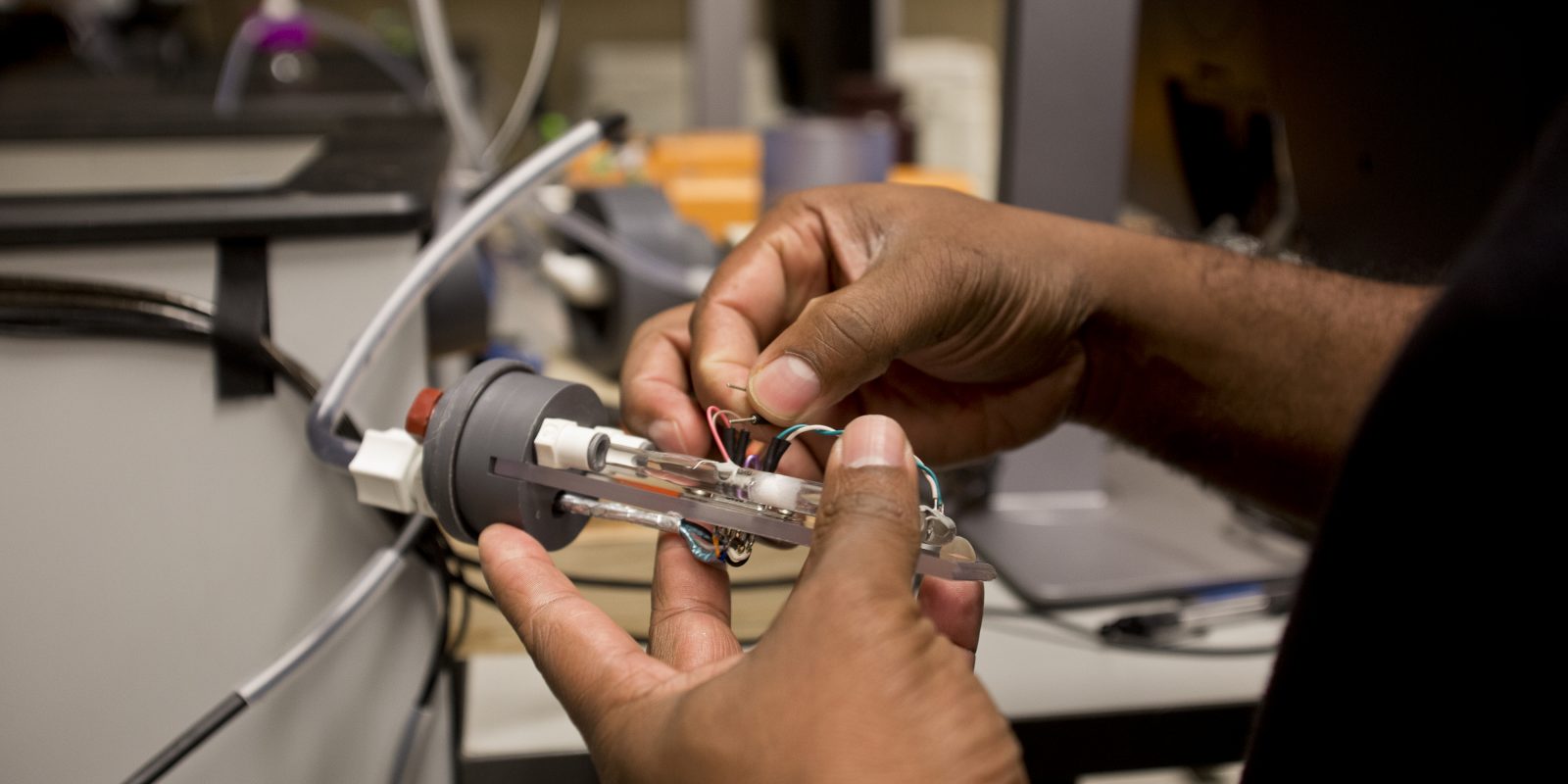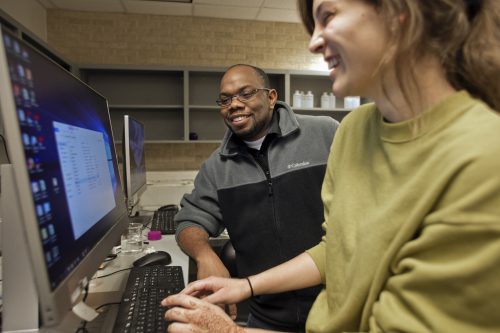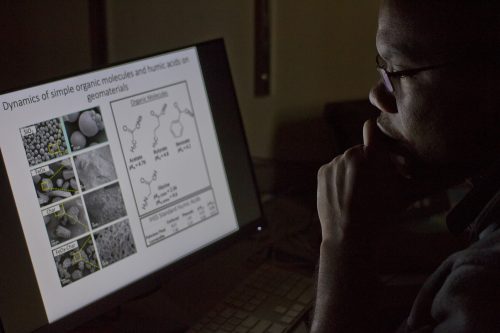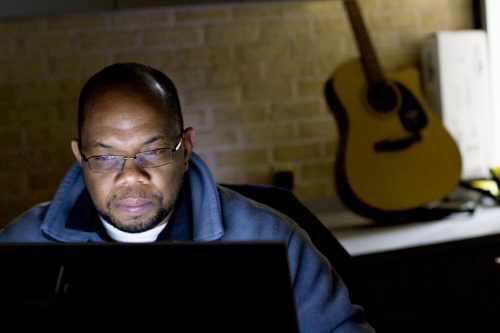
Omar Harvey prepares a sensing unit for the dual calorimeter system. Photo by Mark Graham
Climate Change? Have Another Cup of Coffee
Omar Harvey studies novel ways to capture and store carbon dioxide.
Spent coffee grounds fill garbage bins all over the world. But that trash could be treasure. Omar Harvey is working on ways to turn grounds into a valuable product that could help slow climate change.
Harvey, an associate professor of geology, studies the process of removing carbon from the atmosphere and storing it by a variety of means — underground and in plants and products such as coffee grounds. Mastering an array of carbon sequestration techniques is urgent as humans continue to release carbon dioxide into the atmosphere by burning fossil fuels. In 2018, according to the National Oceanic and Atmospheric Administration, carbon dioxide levels in the atmosphere averaged 407.4 parts per million globally — the highest in 3 million years. And the rate of emissions is increasing.
“Scientists and engineers hold the key to developing sustainable solutions to Earth’s grandest challenges,” Harvey told TCU Magazine in an email. With the help of a $500,000 research grant from the U.S. Department of Energy, he is working on his share of the solution.

Omar Harvey, associate professor of geology, is leading a study of carbon sequestration that could have climate change implications. Caitlin Payblas ’18, a geology graduate student, helps the research effort. Photo by Mark Graham
“It is not the norm for a single PI [principal investigator] to receive such a big grant from a federal agency. I was humbled to be counted among that group,” Harvey wrote.
His study is leading to a better understanding of one type of carbon sequestration, termed geologic sequestration. This form of capture happens when carbon dioxide left over from the burning of fossil fuels is captured from, for example, a power plant’s smokestack, then compressed and pumped underground. Its destination: rock formations like the ones that hold oil or groundwater. Trapped there, it can dissolve in water, become carbonic acid and react with the rock or mineralize to form stable materials like limestone.
Exploring Underground
Doing this right is tricky. It means being able to predict chemical reactions deep underground. It means finding rock formations that don’t contain dangerous elements such as arsenic or lead, with which the carbon dioxide could react and contaminate groundwater. It means careful reconnaissance of proposed storage sites to ensure that no abandoned, forgotten oil wells could offer a path for carbon dioxide to bubble to the surface.
Pitfalls aside, geologic sequestration at smokestacks holds great promise. Because the concentration of carbon dioxide in smokestacks is high, capturing emissions from them is relatively easy compared to stripping it from the air, where the gas is more diluted. Harvey also mentors students who are devising ways to capture carbon from vehicle tailpipes — a technology that, to his knowledge, doesn’t yet exist.

Geologist Omar Harvey is exploring how to capture carbon dioxide from industrial uses and store it in rock formations instead of emitting it into the atmosphere. The Jamaica native built a machine to measure microscopic chemical transfers in his lab at TCU. Photo by Mark Graham
Once drivers switch to electric cars, said Bruce Herbert, a Texas A&M professor who was Harvey’s PhD adviser, the vehicles will have zero emissions. If power plants could be made nearly emission-free by dint of geologic sequestration, then “you have solved one of the greatest challenges of climate change,” he said.
Riddle of Sequestration
But scientists don’t yet understand the complete process of geologic sequestration. With the help of the 2017 grant from the Energy Department, Harvey is studying how carbon-rich molecules bind to and disconnect from aluminum, silicon and iron oxides — minerals commonly found in rocks.
To comprehend the importance of tracing the tiny energy changes associated with those chemical reactions, consider mulch, Harvey said. Gardeners generally buy and apply mulch not just once, but over and over through the years, he said, because mulch tends to lose organic carbon and degrade over time, with the help of microbes. The strength of the bonds between carbon-containing compounds and various minerals determines how this process occurs. The more scientists know about bonds and the energy changes associated with their breakage, the better they understand the requirements to keep carbon in the ground.
Using a flow adsorption microcalorimeter, an instrument that is built from plastic pipe, Harvey measures what happens when carbon-rich natural substances come into contact with mineral oxides, assessing steps in the reaction every five seconds over an hour. That way, he can map out not only which compounds are present at the beginning and end of the reaction, but also all the intermediate compounds and energy changes along the way.
What he learns could make underground carbon storage more practical and help prevent problems like groundwater contamination.
Product Payoffs?
Could carbon sequestration pay for itself? Maybe, Harvey said. In other experiments, he looks for carbon sequestration processes that could result in a value-added product.
For example, he examines how underground microbes living on rock surfaces convert carbon dioxide to methane, the main component of natural gas. Methane is valuable, and if scientists learn how to induce those bacteria to speed up the process, geologic sequestration could become profitable. Researchers could even develop a closed-loop system with a controlled carbon budget: Bacteria would turn sequestered carbon to methane, then scientists would tap and use the methane, capture waste carbon and store it once again to repeat the process.
“It’s very expensive to pump [carbon dioxide] into the ground,” Harvey said. “You need to add value, make that process worth the investment.”
Harvey is also experimenting with value-added biochar, a form of burned plant matter. During photosynthesis, plants pull carbon from the air, then tie it up in their bodies. That’s why reforestation is a good way to sequester carbon. Biochar — charcoal is a familiar example — holds tight to carbon as well. It also makes an excellent soil amendment, suggesting it could be made into a valuable product.

Omar Harvey is researching ways coffee grounds can hold carbon dioxide or even filter water. Photo by Mark Graham
Not all charcoals are created equal, Harvey said, so many experiments are necessary: “The temperature of the fire matters. The material you’re starting with matters.”
In the microcalorimeter, he causes solutions that contain, for example, lead to flow through a tube packed with biochar, then checks to see how the lead reacts with the biochar.
“Then we could predict what would happen to lead in the environment in case of a fire or in case we decided to use these as filters,” he explained.
Slowing the Cycle
Like other forms of biochar, spent coffee grounds sequester carbon by resisting molecular breakdown. But they can also filter and remove contaminants from water. In a world that generates vast amounts of coffee grounds every year, such a filter could be profitable if sold to buyers seeking to purify water, Harvey said.
“Every gram that you convert to biochar, it slows the cycling of carbon, so it buys time for dealing with climate change,” said William Hockaday, an associate geosciences professor at Baylor University and co-mentor of a graduate student with Harvey. “Where [Harvey is] really contributing to that issue with his research is: How do we do that well? … How will it behave once it’s in the environment?”
Harvey grew up in Jamaica and earned a bachelor’s degree at the University of the West Indies in Trinidad and Tobago, then a master’s at the University of Florida. Though he intended to become an agricultural scientist, he grew restless during PhD studies at Texas A&M — “I wanted to do more broader things” — and switched to geology.
Hockaday said he views Harvey as an unusual interdisciplinary scientist, one who is trained in and also comfortable collaborating across disciplines including physics, chemistry and electronics.
Funders, Hockaday added, “recognize [Harvey] as a young scientist who is really doing things that are important and that are likely to change the field.”
Harvey said he thinks of his work not as invention but as discovery.
“We’re just learning science from nature,” Harvey said. “From my perspective, nature is God’s creation. So, for me, it’s learning how God works, who God is. … That’s what makes me tick.”

Your comments are welcome
1 Comment
Related reading:
Research + Discovery
A Silver Bullet for Cancer Treatment?
Nanoparticles may be able to tame an effective but damaging chemotherapy medication.
Alumni, Features
Lighthouse for the Blind CEO Saw the Possibilities
A varied career in business took Platt Allen from data systems, to entrepreneurship, to helping the visually impaired reclaim their lives.
Features
Roxo’s Message on the Panamanian Mangroves
TCU’s student-run strategic communication agency is helping to protect a vital and endangered resource.